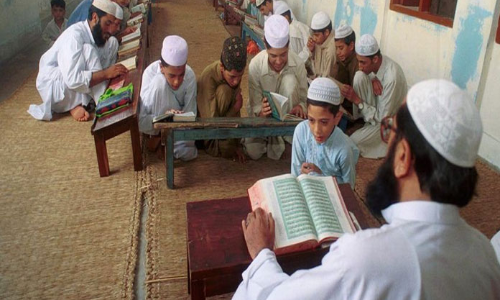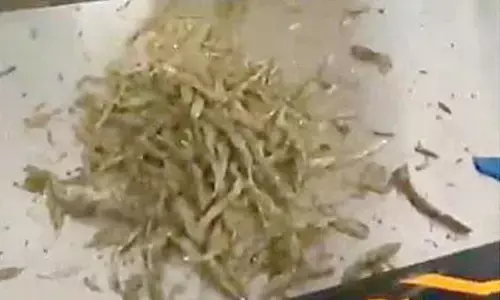The link between madrasas and militancy in Pakistan

When Indian jets pounded Balakot and a couple of other terror training camps in Muzaffarabad and Chakot in the early hours of Wednesday, it resulted in the neutralising of more than 300 terrorists and their trainers and handlers In fact, there was a fresh batch of 75 recruits in the Balakot camp who joined the training base to wage jihad against India, Afghanistan and Iran
When Indian jets pounded Balakot and a couple of other terror training camps in Muzaffarabad and Chakot in the early hours of Wednesday, it resulted in the neutralising of more than 300 terrorists and their trainers and handlers. In fact, there was a fresh batch of 75 recruits in the Balakot camp who joined the training base to wage jihad against India, Afghanistan and Iran.
Where did they come from? For that matter where does one get all those young minds wedded to the cause of jihad from? Where do they get radicalised in the first place? How are they moulded and by whom in their early stages? What provokes them to embark on the suicidal mission?
The answers to such questions are well within the education system in Pakistan that is too heavily dependent on its madrasas.
The Western world looks at the rise of Islamic militancy in Pakistan during 2008 and 2009 and the resulting military operation in the Swat valley which can be traced back to the inculcation of radical ideologies among the youth in the Frontier region. Madrasas have always hogged limelight under these circumstances and there have been conflicting claims regarding their role in fanning terrorism ever since and perhaps, from much before too.
Whether Madrasa's role in it is a myth has also been discussed. Whether one considers a Madrasa as an important issue in education and development of the Islamic world or not is a different issue. Whether those educated in Madrasas always attacked West is not correct as much as those have who attacked India, Afghanistan and Iran.
But, when it came to Swati militants who attacked Western interests and NATO supply lines in Afghanistan, it came to be known that all those militants had a Pakistani Madrasa background. So is the case with those who attacked India more particularly. Though some analysts suggested that Madrasas could be ignored as there were very few of them compared to the Government or private schools, the conclusion has always been misguided.
The education development donors to Pakistan only concentrated on establishing sparkling government schools alongside Madrasas. This only encouraged the Madrasas to resort to a strategy of labelling the government schools in conspiratorial terms which helped them recruit students more zealously from religious families, as it has been observed in Pakistan. Madrasas remained what they were-imparting only religious education- instead of teaching pluralism and conflict resolution skills that should have been facilitated by the Pakistani government with the assistance of other Muslim countries and Ulema.
Madrasas are located all over Pakistan including urban centres like Karachi, Lahore and Islamabad. Students studying in urban centres also came from the remote Northwest Frontier Province too. Pakistani government lacked the will, rather, only had the will to encourage radicalisation. It is not that Pakistan does not have a plan to deal with terrorism on its soil. In the backdrop of Peshawar school attack it went ahead and tried to implement a 20-point programme of reforming the Madrasas, but failed in doing so.
Muhammad Amir Rana, a terrorism expert who helped draft the government’s response to the Peshawar school attack, later told Pakistani media that madrassas pose a “very serious threat” because they set their own criteria for who or what should be considered “enemies of Islam.” “Terrorism has different shades,” Rana said, “but madrassas have been the nursery.” Abdul Hameed Nayyar, a retired Pakistani physics professor who has extensively studied madrassas, said even moderate Islamic schools mix religion with politics and spend considerable time on topics such as jihad.
“They teach this kind of anger, an anger that many perhaps keep under control but others are not able to keep control over, and that anger comes out in the form of jihad,” Nayyar said. Now that is a very potent mix of terrorism. Pakistan might dismiss India's charge that the former is the nursery of terrorism and the cradle of jihad, but it cannot ignore its own experts and academics claims.
It is a known fact that Pakistan’s religious seminaries predate the country’s founding in 1947 and the numbers only grew significantly during the 1980s.
The US is equally responsible for this. The United States and Saudi Arabia were pouring money into religious education in Pakistan in support of the Muslim rebels resisting the Soviet invasion of neighbouring Afghanistan. Later, in the 1990s, some madrasas served as pipelines for militants associated with Pakistani-backed insurgents in Indian-ruled Kashmir. This was extensively reported by the Western media too.
At present there are 26,000 madrasas registered with an umbrella organisation, Ittehad-e-Tanzeemat-e-Madaris. Some Pakistani Interior Ministry officials think that 9,000 others may be unregistered. Though Pakistan closed down 100 Madrasas so far, intelligence estimates suggest that five per cent of Pakistan's Madrasas are very active in jihad and additionally at least 25 per cent more provide the logistics support to groups engaged in armed conflict. The rest can play their bit role anytime.
Let us face the reality. Pakistan today comprises of three types of Muslims. One is the State, which declared itself a Muslim and in which many of its laws are infused with the same Islamic principles taught in Madrasas. The second type is the conservative Muslim and the third, an extremely conservative Muslim (you can safely call him a person with a jihadi mindset).
Saner elements in Pakistan have always been afraid of the development. They have always asked what if a conservative Muslim walks up to an extremely conservative man and says "hey this is too much?" Well, the result will be no different. There is no difference between a conservative man and an extremely conservative one and a radical and a terrorist. When all these are sheltered by a Muslim State, the result will only be terror.
It would be unwise on part of India to ignore this aspect. India has drawn a new line and forced a paradigm shift to its policy on terrorism. It has not changed just the laws but the entire game. It is now in its hand to dictate the course of events in the region.


















